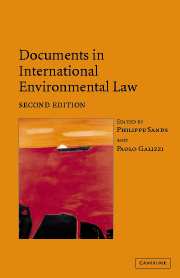Book contents
- Frontmatter
- Contents
- Preface
- PART I General instruments
- 1 Stockholm Declaration of the United Nations Conference on the Human Environment, 16 June 1972
- 2 UN General Assembly Resolution 37/7 on a World Charter for Nature, 28 October 1982
- 3 Rio Declaration on Environment and Development, 16 June 1992
- 4 Draft Articles on Prevention of Transboundary Harm from Hazardous Activities, 2001
- PART II Atmosphere
- PART III Oceans: global
- PART IIIB Oceans: regional
- PART IV Freshwater resources
- PART V Biodiversity
- PART VIA Hazardous substances and activities: nuclear
- PART VIB Hazardous substances and activities: pesticides
- PART VIC Hazardous substances and activities: waste
- PART VII Human rights and the environment
- PART VIII War and the environment
- PART IX Trade and the environment
- PART X Environmental impact assessment and access to information
- PART XI Liability for environmental damage and breaches of environmental obligations
- PART XII The Antarctic
4 - Draft Articles on Prevention of Transboundary Harm from Hazardous Activities, 2001
Published online by Cambridge University Press: 05 June 2012
- Frontmatter
- Contents
- Preface
- PART I General instruments
- 1 Stockholm Declaration of the United Nations Conference on the Human Environment, 16 June 1972
- 2 UN General Assembly Resolution 37/7 on a World Charter for Nature, 28 October 1982
- 3 Rio Declaration on Environment and Development, 16 June 1992
- 4 Draft Articles on Prevention of Transboundary Harm from Hazardous Activities, 2001
- PART II Atmosphere
- PART III Oceans: global
- PART IIIB Oceans: regional
- PART IV Freshwater resources
- PART V Biodiversity
- PART VIA Hazardous substances and activities: nuclear
- PART VIB Hazardous substances and activities: pesticides
- PART VIC Hazardous substances and activities: waste
- PART VII Human rights and the environment
- PART VIII War and the environment
- PART IX Trade and the environment
- PART X Environmental impact assessment and access to information
- PART XI Liability for environmental damage and breaches of environmental obligations
- PART XII The Antarctic
Summary
Editorial note
The Draft Articles on Prevention of Transboundary Harm from Hazardous Activitieswere adopted at the 53rd session of the International Law Commission (2001) and deal with prevention in the context of authorisation and regulation of hazardous activities which may pose a significant risk of transboundary harm.
Article 1 limits the scope of the articles to activities not prohibited by international law and which involve a risk of causing significant transboundary harm through their physical consequences. Article 2 defines the terms used by the Draft Articles and in particular ‘harm’ includes harm caused to persons, property or the environment (Article 2(b)). The State of origin of the activities likely to cause significant transboundary harmshall take appropriate measures to prevent or minimise the harm and risk related to such activities (Article 3). States shall co-operate in good faith (Article 4) and adopt the necessary internal measures to implement the provisions of the Draft Articles (Article 5). The State of origin shall require prior authorisation for activities covered by the Draft Articles to be carried out on its territory or under its jurisdiction or control (Article 6). Decisions on the authorisation required by the State of origin shall be based on an assessment of the possible transboundary harm caused by a given activity (Article 7). The State of origin, in case of risk of significant transboundary harm, shall provide the State likely to be affected with timely notification and transmit the available technical and other relevant information (Article 8).
- Type
- Chapter
- Information
- Documents in International Environmental Law , pp. 24 - 30Publisher: Cambridge University PressPrint publication year: 2004



